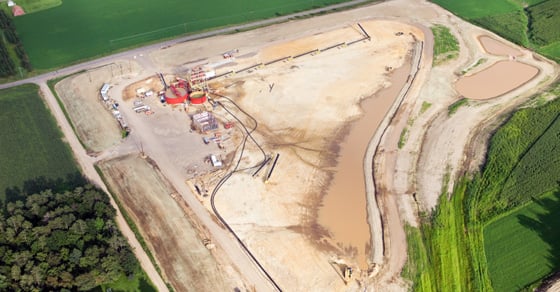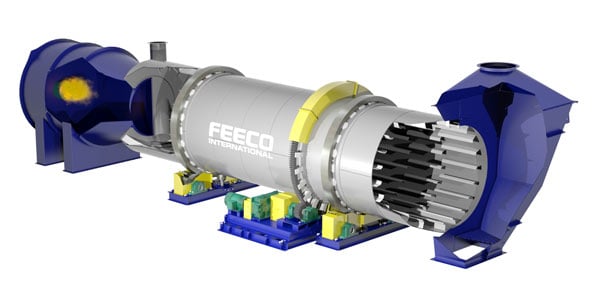The frac sand industry is seeing a major resurgence, with experts predicting record demand for the silica-based sand.
The boom, garnering nicknames such as Proppacalypse, has many expecting to see proppant demand set an all-time high in 2017, despite a much lower rig count compared to 2014, with some even anticipating a 2018 shortage.
FEECO has already seen the stirrings of a resurgence first-hand, with sand dryer inquiries on the rise.
The Role of Frac Sand
Not just any sand can be labeled “frac sand;” to be considered suitable for fracking operations, the silica sand must meet a variety of qualifications, set forth by the American Petroleum Institute (API). Among the requirements are specifications on crush strength, sphericity and roundness, particle size, and more.
Frac sand is pumped into wells deep underground in order to “prop” and hold open rock fissures so that natural gas or oil can flow out. This requires the sand to be very strong and capable of withstanding extreme pressures. The highest quality frac sand, often referred to as northern white sand, is found in the upper Midwest of the United States, most notably in the state of Wisconsin.
Fracking is not a new technology, but recent advancements have caused it to become a mainstream method of oil and gas extraction in the energy sector.
What’s Causing the Renewed Frac Sand Boom?
While the oil industry is nowhere near its former $100 per barrel glory, well efficiencies have allowed shale producers to reduce their break-even point. The break even point used to fall at around $50 per barrel, but has since dropped to around $30 per barrel. This increased efficiency and corresponding lower break-even point allows producers to be profitable even at lower prices.
And while this has instilled confidence in the industry in general, one factor is increasing demand for frac sand specifically: the amount of sand used per well.
Increase in Sand Volume per Well
Many rigs were shut down during the industry downturn, but rig count is again on the rise. And although there are not nearly as many active rigs as during the industry’s peak, the amount of sand used at each rig is increasing. Increasing the amount of sand per well has become an industry trend over the past few years, and can be attributed to a few key factors:
- Proppant Intensity is Increasing: Producers have found that increasing the amount of sand used per well generally translates to higher production rates.
- Increasing Lateral Lengths: The lateral lengths of horizontal wells is becoming greater, necessitating a need for more sand.
- More stage counts: Fracking stages are the zones along a horizontal well which are fracked. Stage counts have also been on the rise in recent years.
As reported earlier in the year by Rigzone.com, analysts at Raymond James said that between the Permian Basin, Eagle Ford, and Bakken, the pounds per lateral foot of proppants per well has increased more than 50% since 2014. The analysts go on to say,
“Furthermore, with our expectations for an increasing U.S. rig count over the next few years, U.S. sand demand in 2018 should be at least 150 percent higher than 2016 – up to a whopping 80 million tons.”
Increasing Demand: Not Just for Sand
The renewed fracking boom is not limited to sand, however; labor crews and equipment have also seen a subsequent surge.
Labor Crews
Producers are seeing a shortage of labor crews. The industry’s recent collapse forced many workers out of the field. And while some are happy to come back, the industry is not where it used to be. Bloomberg Markets reports that some drillers underspent their first quarter budgets as a result of a lack of workers to achieve planned production. Bloomberg also reports that competition for workers among companies is stiff, with some crews leaving their contracted position for higher paying contracts, even despite early termination penalties.
Frac Sand Processing Equipment
While frac sand is a naturally occurring material, it must go through some processing before it is ready for well injection. Not surprisingly, when the demand for sand increases, so too does the need for processing equipment; producers are dusting off mothballed facilities and investing in new ones.
Excavated frac sand must be washed, dried, and screened, in order to remove any impurities. It is then sorted into various grades. Depending on the unique sand source, other steps may be necessary to prepare the silica sand for fracking.

FEECO has seen the resurgence of sand processing equipment demand first-hand, particularly in relation to frac sand dryers, conveyors, and bucket elevators.
“We’re definitely seeing more activity around frac sand lately,” says Shane Le Capitaine, FEECO Process Sales Engineer. “Companies are excited to get things going again, and they’re looking for high capacity equipment that can meet their demands. That’s where we can help.”
The dryer is of particular importance, as transporting excess moisture is costly and inefficient. Drying is typically carried out in a rotary dryer, a robust industrial drying system known for its reliability, high throughput, and toleration of variation in feedstock.

3D Model of a FEECO Frac Sand Dryer
Conclusion
The fracking industry is in the midst of another boom, bringing with it increased demand for frac sand, labor crews, and frac sand processing equipment.
FEECO has been serving the industry with a centrally-located source of equipment and parts and service support since its mainstream adoption. We offer heavy-duty rotary dryers and material handling equipment designed for the demanding setting that sand processing requires. For more information on our frac sand capabilities, contact us today!


